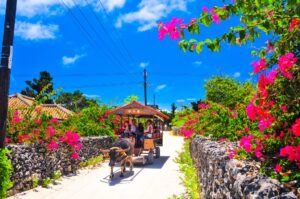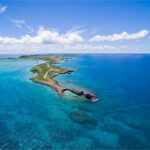Contents
- 1
- 1.1 2. History and Cultural Background
- 1.2 3. Traditional Village and Architecture
- 1.3 4. Best Beaches on Taketomi
- 1.4 5. Cultural Experiences and Local Life
- 1.5 6. Local Cuisine
- 1.6 7. Getting to Taketomi Island
- 1.7 8. Getting Around the Island
- 1.8 9. Best Time to Visit
- 1.9 10. Where to Stay
- 1.10 11. Travel Etiquette and Tips
- 1.11 12. Nearby Islands
- 1.12 Final Thoughts
Just a short ferry ride from Ishigaki Island lies a small coral island where time seems to have stopped.
Taketomi Island (竹富島), part of Okinawa’s Yaeyama Islands, is famous for its traditional red-tiled houses, white coral sand streets, and slow island lifestyle that preserves the charm of the old Ryukyu Kingdom.
Recognized as a Nationally Important Preservation District for Groups of Traditional Buildings, Taketomi offers travelers a rare chance to step into a living museum of Okinawan heritage, surrounded by turquoise seas and warm smiles.
1. Overview

-
Location: About 6 km southwest of Ishigaki Island, Okinawa Prefecture
-
Area: 5.4 km² — small enough to explore by bicycle
-
Population: Around 300 residents
-
Access: 10-minute ferry from Ishigaki Port
Taketomi Island belongs to the Yaeyama Islands, Japan’s southernmost inhabited region. Despite its size, it attracts visitors from around the world who seek authentic Okinawan scenery, peaceful beaches, and warm island hospitality.
2. History and Cultural Background
Taketomi has been inhabited for centuries and was once part of the Ryukyu Kingdom (1429–1879), which maintained a unique culture distinct from mainland Japan.
The island flourished as a trading and fishing village, and many customs, festivals, and songs from the Ryukyu era are still practiced today.
Residents have worked together for decades to preserve their cultural identity, maintaining strict rules about building design and village cleanliness. The entire island is protected under Japanese cultural heritage law — making it one of the best-preserved Ryukyu-style villages in existence.
3. Traditional Village and Architecture
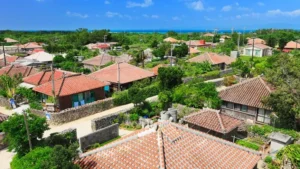
The heart of Taketomi is its beautifully preserved village, where every house follows traditional Ryukyuan design principles:
-
Red-tiled roofs with “Shisa” lion-dog statues to ward off evil spirits
-
Coral stone walls enclosing private homes
-
White sand streets, swept daily by locals
-
Blooming hibiscus and bougainvillea adding color to every lane
Cars are rare, and the atmosphere is tranquil. The village feels like a step back in time — no billboards, no neon signs, only the sound of cicadas and the distant sea breeze.
Tip: Wear sunglasses — the sun reflecting off the white coral sand is dazzling!
4. Best Beaches on Taketomi
Despite its small size, Taketomi boasts some of Okinawa’s most scenic beaches with crystal-clear waters and soft coral sand.
Kondoi Beach (コンドイ浜)
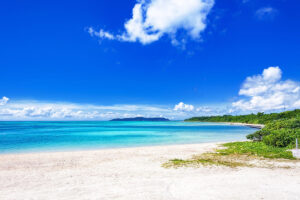
-
The island’s most famous beach
-
Calm, shallow waters — ideal for swimming and families
-
Tides create a vast sandy area at low tide, perfect for strolling or relaxing
-
Facilities include toilets and showers
Kaiji Beach (カイジ浜) – “Star Sand Beach”
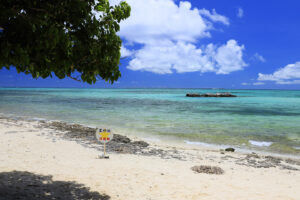
-
Famous for its star-shaped sand grains (tiny shells of marine organisms called Foraminifera)
-
Swimming is prohibited due to strong currents, but it’s perfect for photography and sand collecting
-
Small shops nearby sell bottles of “star sand”
Aiyaru Beach
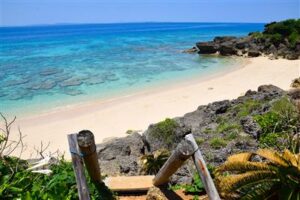
-
Less crowded and natural, popular among locals and photographers
-
Offers a more tranquil, untouched atmosphere
5. Cultural Experiences and Local Life
Taketomi isn’t just about scenery — it’s a place where tradition lives through daily life. Visitors can experience authentic Ryukyuan culture in many ways:
-
Water Buffalo Cart Ride: Enjoy a slow tour of the village in a traditional ox-drawn cart while a local guide plays the sanshin (three-stringed instrument) and sings folk songs.
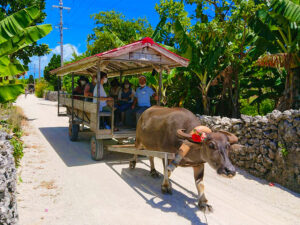
-
Village Walks: Explore coral-lined lanes, small shrines, and traditional homes.
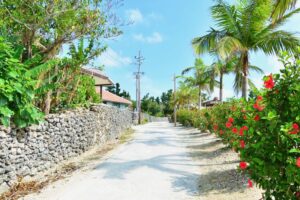
-
Festivals:
-
Tanadui Matsuri (October): The island’s biggest festival with traditional dances, songs, and rituals that date back 600 years.
-
-
Craft Workshops: Try making shell accessories or weaving with local materials.
Everyday life on Taketomi revolves around community, respect, and harmony with nature — a spirit that visitors are encouraged to appreciate.
6. Local Cuisine
Taketomi’s food reflects Okinawa’s healthy and flavorful island diet, using local vegetables, pork, and seafood.
Must-try dishes:
-
Yaeyama Soba: A local noodle soup topped with pork, fish cake, and scallions — lighter than mainland ramen.
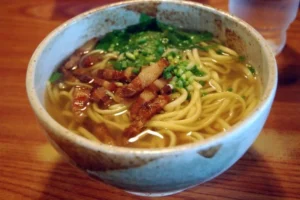
-
Goya Champuru: Stir-fried bitter melon with tofu, egg, and pork.
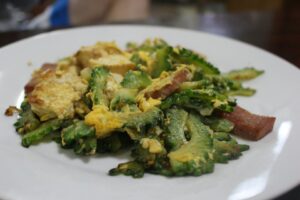
-
Grilled Island Fish: Freshly caught, simply seasoned with salt.
-
Shikuwasa Juice: Refreshing local citrus drink.
-
Awamori: Traditional Okinawan distilled liquor — smooth but strong!
Small family-run cafés and guesthouses serve homemade meals featuring local ingredients and island hospitality.
7. Getting to Taketomi Island
The only way to reach Taketomi is by ferry from Ishigaki Island.
From Ishigaki Port (石垣港離島ターミナル):

-
Ferry Time: About 10–15 minutes
-
Frequency: Every 30–60 minutes (operated by Yaeyama Kisen and Anei Kanko)
-
Fare: Around ¥1,000 one way
-
Tip: No need to book in advance — just show up at the terminal 15 minutes before departure.
Nearest Airport:
-
New Ishigaki Airport (Painushima) — connects to Tokyo, Osaka, Naha, and other Japanese cities.
From the airport, take a 30-minute bus or taxi to the ferry terminal.
8. Getting Around the Island
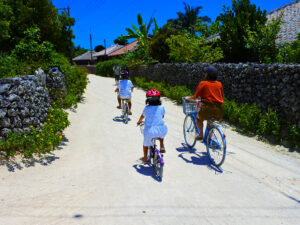
Taketomi is small — walking, cycling, or water buffalo cart are the best ways to explore.
-
Bicycle Rental: Available near the ferry port; costs around ¥1,500–¥2,000 per day.
-
Water Buffalo Cart Tour: 30–40 minutes, ¥1,500 per person.
-
Walking: The village is compact; 15 minutes from one end to another.
-
Cars: Not allowed for tourists — preserving the peaceful atmosphere.
Tip: Bring sunscreen and water — shade is limited.
9. Best Time to Visit
| Season | Highlights | Notes |
|---|---|---|
| Spring (Mar–May) | Pleasant weather, blooming flowers | Ideal for cycling and photography |
| Summer (Jun–Sep) | Crystal-clear seas, swimming season | Hot and humid; occasional typhoons |
| Autumn (Oct–Nov) | Festivals, comfortable temperatures | Great time for cultural visits |
| Winter (Dec–Feb) | Quiet atmosphere, mild weather | Cooler evenings, fewer crowds |
The island enjoys subtropical weather year-round, rarely dropping below 18°C (64°F).
10. Where to Stay
Though small, Taketomi offers charming accommodation options — from traditional inns to boutique hotels.
-
Minshuku (Family Inns): Stay with locals, enjoy home-cooked meals.
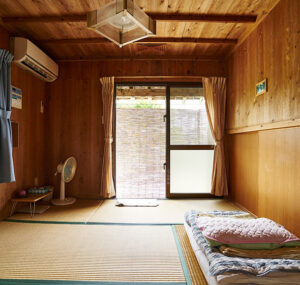
-
Guesthouses: Budget-friendly, social atmosphere.

-
Luxury Option: HOSHINOYA Taketomi Island — a high-end eco-resort blending luxury with traditional architecture and island culture.
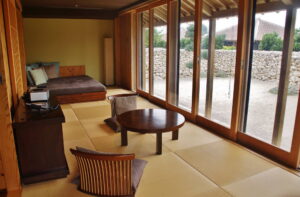
Advance booking is highly recommended, especially in summer.
11. Travel Etiquette and Tips
-
Respect the locals: Taketomi is a living community, not an open-air museum.
-
Keep quiet at night: Sound carries easily in the peaceful village.
-
Stay on marked paths: Do not enter private property.
-
Do not take coral or sand: Especially “star sand” — buy it from official shops instead.
-
Cash only: Few ATMs; bring yen from Ishigaki.
-
Wi-Fi: Limited; most travelers enjoy the digital detox.
12. Nearby Islands
Taketomi is part of the Yaeyama Archipelago, making it easy to explore other stunning islands:
-
Iriomote Island: Jungle treks, waterfalls, and mangroves — perfect for adventure seekers.
-
Kohama Island: Quiet, scenic, and great for cycling.
-
Ishigaki Island: Main hub for transport, dining, and nightlife.
-
Hateruma Island: Japan’s southernmost inhabited island — turquoise paradise.
Daily ferries connect all these islands via Ishigaki Port.
Final Thoughts
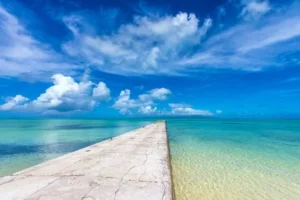
Taketomi Island is a rare place where the rhythm of modern life slows to match the sound of the waves and the creak of a water buffalo’s cart.
It’s not just a destination — it’s an experience of Okinawa’s soul, where tradition, community, and nature remain beautifully intertwined.
Whether you come for a few hours or stay for a few nights, Taketomi will remind you of the beauty of simplicity — and the warmth of island life that never fades.
Related articles
Official Website
https://visitokinawajapan.com/destinations/yaeyama-islands/taketomi-island/
Accommodation sites
Agoda
